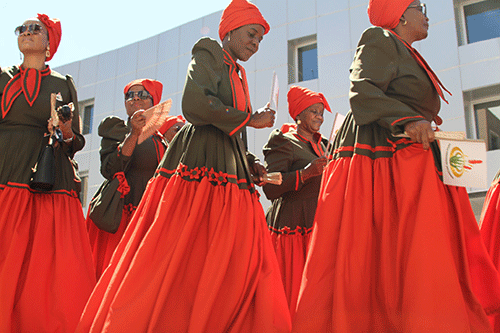Pricilla Mukokobi
Taking inspiration from the rich greens and oranges of the Aloe Vera plant found in Windhoek, the ǂNīsa Damaradi |Ae||gams group on Saturday launched its unique traditional dress.
Dantago Hiskia, a member of the planning team, told VIBEZ! the Horokhoes (dress) was designed and made for Damaradi (Damara women) who reside in |Ae||gams (Windhoek).
She said the Oukoreb (Aloe Vera plant) was identified as the perfect plant to represent the group because it is an endangered species and has unique, beautiful colours.
“The green represents the colour of the Aloe Vera plant, while the orange represents the plant’s flower when it blossoms – and the neckpiece represents the leaves,” Hiskia explained.
Normally, the Damaradi wear patched dresses as a symbolic gesture to weddings, while it also represents the numerous chores women have at home on a daily basis.
Hiskia said giving back to the community is one of the reasons they launched the Windhoek dress.
“We do charity events; therefore, if there’s anyone out there willing to sponsor the initiative of team Windhoek and whatever activities we want to do, we will appreciate it – be it corporate, individuals or families to say,” she said.
The launch follows hot on the heels of the unveiling of ǂNīsa Taradi Horokhoes Group in Tsumeb some two weeks ago.
Similar launches also took place in various other towns and villages.
At Tsumeb, the ǂNīsa Taradi Horokhoes Group chose the colour copper for their dresses to represent their town’s natural treasure – copper.
The aim is to encourage the young Khoekhoegowab-speaking girls to wear the dress to signify unity among the Damaran in spite of the different clans they come from.
More towns will launch their unique dresses too.
The Damara men also showed off their traditional attire, comprising shirts, with a combination of Springbok hide and beige fabric.
!Gawax’mâ !Khâxa lKharu lNaniseb, senior headman of the !Ainîdaman clan explained the men’s traditional attire:
“The beige colour of the soil shows we are of this land; we belong to this land – and when we pass on, we return to the land.”
He said, like all African tribes, Damara men also used to wear animal hide – and for their updated modern attire, they chose Springbok hide.
It can be anywhere on the shirt, he said. They finish the look with brown hats, with a strip of Springbok hide on them too.
The headman further said the gathering on 1 April means a lot to the ǂNūkhoe (Damaran) people.
“We are so proud of our women because our ancestors are very happy to see the youth wearing the traditional dress,” he said.
Meanwhile, the ǂNūkhoe will, in three weeks’ time, launch their clan dresses.
“So, each clan will be wearing their clan dresses. We are trying to allow the youth to know where they belong, and know the colour of their clan. Lastly, we want the youth to know what their clan do,” Hiskia said.
– epicnakwezy@gmail.com


